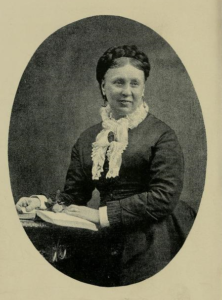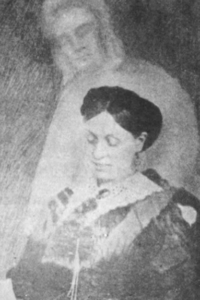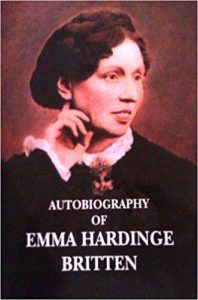EMMA HARDINGE BRITTEN TIMELINE
1823 (May 2): Emma Hardinge Britten was born Emma Floyd in London, England, where she trained for a career as a musician and actress.
1844–1853: Emma Floyd performed at London’s Adelphi Theater, taking the stage name Emma Hardinge.
1855: Emma Hardinge and her mother moved to New York City.
1856 (February 19): Hardinge became a spirit medium upon receiving a spirit message from a deceased crew member of a ship that had been expected in New York weeks earlier, but had sunk.
1857 (July 5): Hardinge delivered her first public lecture in Troy, New York.
1859–1860: Hardinge went on a tour of the American South to promote Spiritualism.
1860: Hardinge published Six Lectures on Theology and Nature and began to campaign for poverty-stricken “outcast” women.
1864–1865: Hardinge was hired by the California Union Party, to lecture in favor of Abraham Lincoln’s reelection as United States President.
1865 (April 14): Hardinge delivered a eulogy for President Lincoln in New York only a few days after his assassination.
1866: Hardinge published Extemporaneous Addresses, a collection of her lectures.
1869: Modern American Spiritualism was published, and established Britten as a leading historian of the nineteenth-century Spiritualist movement.
1870 (October 11): Hardinge married Spiritualist William Britten.
1871: Following a lecture in London, Emma Hardinge Britten claimed that, through spirit communication, she had been given the “Ten Commandments of Spiritualism” by the late philosopher and socialist Robert Owen.
1872: While living in Boston, the Brittens started the Western Star, a Spiritualist journal, which ceased publication after only six issues.
1875: Emma Harding Britten became a founding member of the New York Theosophical Society and a member of its first council.
1878–1879: The Brittens traveled to Australia and New Zealand as Spiritualist missionaries.
1881: The Brittens returned to England and settled in Manchester.
1884: Emma Harding Britten published Nineteenth Century Miracles, a history of Spiritualist practice around the world.
1887: The Brittens started the Spiritualist publication The Two Worlds.
1889: Emma Hardinge Britten published Faiths, Facts and Frauds of Religious History, a critique of Christianity.
1894: William Britten died.
1899 (October 2): Emma Hardinge Britten died in Manchester, England.
1900: The Autobiography of Emma Hardinge Britten was published by Emma’s sister, Margaret Wilkinson.
BIOGRAPHY
Emma Hardinge Britten was born Emma Floyd in London, England in 1823. Her father was a schoolmaster (Byrne 2012) and a sea captain (Braude 2000) who died when the family was living in Bristol, at which time Emma was only eleven years old. After her father’s death, Emma had to support the family, and began teaching music. Emma had two siblings, Tom and Margaret, but little is known about them except that Tom died at sea around 1841 (Demarest 2012:27). In her autobiography, Emma claims to have been aware of her psychic abilities from a young age (Britten 1900:3). In addition to being a musician, the young Emma was also a talented vocalist who trained for a career on the stage, performing primarily at the Adelphi  Theater in London. As a teenager, Emma also had some exposure to the occult, working as a clairvoyant for a group she referred to as the “Orphic Circle” (Mathiesen 2006:202).
Theater in London. As a teenager, Emma also had some exposure to the occult, working as a clairvoyant for a group she referred to as the “Orphic Circle” (Mathiesen 2006:202).
In 1850, Emma Floyd began to appear onstage as Emma Hardinge. [Image at right] Since there was no evidence that she had married, this was presumably a stage name (Demarest 2012:39). In 1855, Emma Hardinge and her mother moved to New York City ostensibly for Emma to start a career on Broadway. However, once in New York, Hardinge discovered Spiritualism, gave up her stage career, and began holding séances at Horace Day’s Society for Diffusion of Spiritual Knowledge in midtown Manhattan. As a medium and trance speaker, Hardinge’s skills were in demand for leading séances, but she also had a flair for public speaking and began to travel on the Spiritualist lecture circuit, delivering her first public lecture in Troy, New York in 1857. After her lecture at Troy, much of Hardinge’s career came to be characterized by travel. Prior to the American Civil War (1861–1865), Hardinge toured the South to raise Spiritualism’s profile, but her lectures met with hostility from local audiences who disliked the fact that she was an abolitionist. In 1864, the California Union party hired Hardinge to lecture in favor of the reelection of Abraham Lincoln (Braude 2000). On April 14, 1865, just three days after Lincoln’s assassination, Hardinge eulogized him in a speech delivered in New York City.
In 1869, Hardinge published the two-volume Modern American Spiritualism, a work providing a history of the first two decades of the Spiritualist movement. In 1870, Hardinge married William Britten, a Boston Spiritualist, and in 1872, the couple attempted to start a Spiritualist journal, The Western Star. The journal ceased publication when subscriptions dropped after a fire devastated Boston that same year. The Brittens returned to New York City and, between 1875 and 1876, they helped to found the Theosophical Society, acting as council members. Due to alleged differences of opinion between Emma Hardinge Britten and co-founder Helena P. Blavatsky (1831–1891), the Brittens left the Theosophical Society and returned to Spiritualism (Mathiesen 2006:203). In 1876, the Brittens published two books together: Art Magic, a treatise on the history of magic, and a novel entitled Ghost Land. Between 1878 and 1879 the Brittens traveled to Australia and New Zealand to spread the word about Spiritualism. They moved to Manchester, England in 1881, and there Emma Hardinge Britten finished her book Nineteenth Century Miracles, documenting the spread of Spiritualism outside of the United States. In 1887, the Brittens started the Spiritualist publication The Two Worlds, and in 1894, William Britten died. Emma Hardinge Britten died five years later, in 1899. Her autobiography was published posthumously in 1900 by her sister.
TEACHINGS/DOCTRINES
Spiritualist belief is based on the premise that the living can communicate with spirits of the dead through a spirit medium once he or she goes into a trance and is “controlled” by otherworldly intelligences (Deveny 2006:1074). Spiritualism was condemned by the Catholic Church and widely scorned by mainstream nineteenth-century society. However, this new “scientific” religion was also an object of fascination for people from all walks of life. Britten worked hard to raise Spiritualism’s profile and representation in the public sphere and to differentiate upstanding or “genuine” Spiritualists from frauds. Britten was also highly concerned with disavowing the “Free Love” movement identified with Spiritualists such as Victoria Woodhull (1838–1927). [See, Women in Nineteenth Century American Spiritualism]. Further, unlike other prominent Spiritualists, Britten saw Spiritualist mediumship as being part of an ancient occult tradition that had originated with magicians, mystics, alchemists, and witches. She wanted to revive the study of magic and emphasize these connections (Mathiesen 2006:202).
Unlike Andrew Jackson Davis (1826–1910), who saw the universe as being populated exclusively by living humans and the spirits of dead ones, Britten believed that (through magic and occult practice) there could be “God-men . . . heavenly men, strong and mighty Powers, Thrones, Dominions, World Builders” (Britten and Britten 1876:273), that is, humans who were, in effect superhuman, or in Theosophical terms “masters.” This belief, which relies on Theosophical occult hierarchies is at times incompatible with the deliberately democratic and non-hierarchical structure of Spiritualism.
RITUALS/PRACTICES
Emma Hardinge Britten was one of the first to write brief “official” guides to Spiritualist practice, including instructions on how to run a séance and on how to investigate mediums for fraud (Mathiesen 2006:203). But for the most part, Britten began to practice Spiritualism very  much as other women of her era did, leading private séances and disseminating spirit messages. However, like many nineteenth-century mediums [See, Fox Sisters], Britten claimed to have received an otherworldly calling to appear before larger audiences, and so, despite that era’s prohibitions on women speaking in public. began to deliver public lectures to mixed audiences. Much of her practice as a Spiritualist speaker therefore meant entering a trance state in which she was controlled by a spirit guide who would give her the insight to hold forth on all manner of topics. [Image at right] Notably, following a lecture in London in 1871, Hardinge Britten claimed that she had been given the “Ten Commandments of Spiritualism” by the late philosopher and socialist Robert Owen (1771–1858). These would later become the “Seven Principles of Spiritualism” adopted by the Spiritualist Church and referenced to this day (“7 Principles” 2018).
much as other women of her era did, leading private séances and disseminating spirit messages. However, like many nineteenth-century mediums [See, Fox Sisters], Britten claimed to have received an otherworldly calling to appear before larger audiences, and so, despite that era’s prohibitions on women speaking in public. began to deliver public lectures to mixed audiences. Much of her practice as a Spiritualist speaker therefore meant entering a trance state in which she was controlled by a spirit guide who would give her the insight to hold forth on all manner of topics. [Image at right] Notably, following a lecture in London in 1871, Hardinge Britten claimed that she had been given the “Ten Commandments of Spiritualism” by the late philosopher and socialist Robert Owen (1771–1858). These would later become the “Seven Principles of Spiritualism” adopted by the Spiritualist Church and referenced to this day (“7 Principles” 2018).
LEADERSHIP
Hardinge Britten was a prolific writer, an indefatigable traveler, and a compelling public speaker who helped to raise the profile of the Spiritualist movement. Britten vouched for Spiritualism’s respectability, attempting to validate Spiritualist practice and address common criticisms of it (Youngkin 2016:52). As such, Britten is often described as being one of the most influential proponents of nineteenth-century Spiritualism, and she remains a significant figure in the history of new religious movements because of her role as a historian: she was the first to comprehensively articulate and promote Spiritualism’s origin story through narrative (McGarry 2012:29–30). [Image at right] Her best-known books, Modern American Spiritualism (1869) and Nineteenth Century Miracles (1884) continue to be landmark publications in the history of Spiritualism. These publications helped to define Spiritualism and shape its history by identifying its key players. Modern American Spiritualism, in particular, was well received within the Spiritualist community, and was described in the American Spiritualist journal Banner of Light as a “truly elegant work, the crowning piece of Mrs. Hardinge’s public career” (“Mrs. Hardinge’s New Book” 1870:4). In her work, Britten strived to differentiate Spiritualism from other new religions of the time by promoting its value as a “scientific” religion and its liberatory potential as a social movement. Finally, Britten’s personal beliefs were deeply embedded in her practice as a Spiritualist; she was especially interested in protecting impoverished, women at risk, and campaigned to lift social and legal prohibitions against women.
the first to comprehensively articulate and promote Spiritualism’s origin story through narrative (McGarry 2012:29–30). [Image at right] Her best-known books, Modern American Spiritualism (1869) and Nineteenth Century Miracles (1884) continue to be landmark publications in the history of Spiritualism. These publications helped to define Spiritualism and shape its history by identifying its key players. Modern American Spiritualism, in particular, was well received within the Spiritualist community, and was described in the American Spiritualist journal Banner of Light as a “truly elegant work, the crowning piece of Mrs. Hardinge’s public career” (“Mrs. Hardinge’s New Book” 1870:4). In her work, Britten strived to differentiate Spiritualism from other new religions of the time by promoting its value as a “scientific” religion and its liberatory potential as a social movement. Finally, Britten’s personal beliefs were deeply embedded in her practice as a Spiritualist; she was especially interested in protecting impoverished, women at risk, and campaigned to lift social and legal prohibitions against women.
ISSUES/CHALLENGES
Women who wrote about Spiritualism and who identified as Spiritualist mediums were writing from marginalized social positions and were often dismissed. [See, Women in Nineteenth Century American Spiritualism]. Further, women were disallowed from speaking in public before audiences that included men. However, Britten circumvented criticism for violating this prohibition by claiming that the spirits had demanded it of her and therefore she could not refuse (Britten 1900:62). Unlike most female trance speakers of her era, Britten grew emboldened to disseminate her views on politics and often aroused the ire of devoutly Christian or otherwise socially conservative audience members, both in the United States and beyond. Britten therefore often feared for her safety. For example, she describes being run out of Rondout, New York by people who accused her of being a witch (Britten 1900:85). Finally, although Britten had been an indefatigable traveler throughout her life, the loss of her husband affected her profoundly, and she made no more public appearances until she died in 1899.
IMAGES
Image #1: Britten in 1884, taken when she was in her early sixties.
Image #2. An image of Britten in a trance, taken by spirit photographer William Mumler.
Image #3: A portrait of Britten that was eventually used on the cover of her posthumous autobiography.
REFERENCES
“7 Principles.” 2018. Spiritualist National Union. Accessed from https://www.snu.org.uk/7-principles on 14 August 2018.
Britten, Emma Hardinge. 1900 [Republished 1996]. Autobiography of Emma Hardinge Britten. (First published 1900 by Mrs. M. Wilkinson.) Stansted, England: SNU Publications, 1996.
Britten, Emma Hardinge, and William Britten. 1876. Art Magic: Mundane, Sub-Mundane, and Super-Mundane Spiritism. New York: William Britten. Accessed from https://archive.org/stream/artmagicormundan00brit#page/n7/search/heavenly+men on 5 August 2018.
Braude, Ann D. 2000. “Britten, Emma Hardinge.” American National Biography. Accessed from https://doi.org/10.1093/anb/9780198606697.article.0801862 on 5 August 2018.
Byrne, Georgina. 2012. “Britten [née Floyd], Emma Hardinge (1823–1899).” Oxford National Biography. Accessed from https://doi.org/10.1093/ref:odnb/70567 on 5 August 2018.
Demarest, Marc. 2012. “Back from Jerusalem: Emma Hardinge Britten, Spiritualist Propagandist.” Version 2.1. The Emma Hardinge Britten Archive. Accessed from http://www.ehbritten.org/video/module5.pdf on 5 August 2018.
Deveny, John Patrick. 2006. “Spiritualism.” Pp. 1074–82 in Dictionary of Gnosis and Western Esotericism, edited by Wouter J. Hanegraaff. Leiden: Brill.
Mathiesen, Robert. 2006. “Britten, Emma (Floyd) Hardinge.” Pp. 202–05 in Dictionary of Gnosis and Western Esotericism, edited by Wouter J. Hanegraaff. Leiden: Brill.
McGarry, Molly. 2012. Ghosts of Futures Past: Spiritualism and the Cultural Politics of Nineteenth-Century America. Berkeley: University of California Press.
“Mrs. Hardinge’s New Book.” 1870. Banner of Light. January 15.
Youngkin, Molly. 2016. “A ‘Duty’ to ‘Tabulate and Record’: Emma Hardinge Britten as Periodical Editor and Spiritualist Historian.” Victorian Periodicals Review 49:49–75.
Post Date:
6 September 2018
